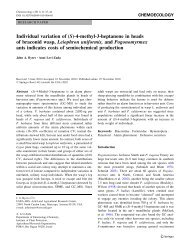EFFECTIVE ATTRACTION RADIUS: A Method ... - Chemical Ecology
EFFECTIVE ATTRACTION RADIUS: A Method ... - Chemical Ecology
EFFECTIVE ATTRACTION RADIUS: A Method ... - Chemical Ecology
Create successful ePaper yourself
Turn your PDF publications into a flip-book with our unique Google optimized e-Paper software.
760 BYERS ET AL.<br />
and Kinghom, 1958). Also, a conversion from the width of flat traps to a diameter<br />
(2 x radius) for tubular traps must be done according to the average trap<br />
interception area:<br />
2 • radius = 2 x width * 7r -1 f cos A = 0.637 • width<br />
Thus, assuming a 5-hr flight for each day of a 37-day test and 2 m/sec speed<br />
of beetle or wind, then Cuthbert and Peacock (1975) had a density of flying S.<br />
multistriatus in the healthy elms (0-12 m height) of 1/hectare and in the diseased<br />
elms of 2069/hectare. The results of Schmitz (1980) for I. pini can be<br />
similarly adjusted to yield an average density of 43/hectare (0- to 17-m height)<br />
at 45 m away from a source of pheromone. Byers et al. (1985) report a catch<br />
of 52 T. piniperda on two blank sticky traps (25 cm diam.) for 15 hr (time<br />
unpublished) during the maximum swarming, which yields about 401 flying<br />
beetles per hectare (0-.10 m), clearly a higher population level than that in Table<br />
1.<br />
Our method of flight density estimation assumes that beetles do not avoid,<br />
or are attracted to, the passive traps and thus cause us to under- or overestimate<br />
the population level. Nijholt (1983) questioned whether sticky-screen traps<br />
appear transparent to bark beetles because he found a nonrandom distribution<br />
of catch on a 60 x 80-cm-wide screen held 60 cm above ground. The average<br />
catch of the peripheral areas of the trap was less than the center. However, it<br />
is possible that through the beetles' movements to free themselves from the<br />
stickem, they gradually slid down the sticky screens so that the top periphery<br />
of the trap was depleted of beetles over time, thus accounting for the difference.<br />
Furthermore, the bottom area may have caught less beetles simply because fewer<br />
beetles fly near the ground.<br />
Bark beetles are known to respond to visual silhouettes of the size of a tree<br />
trunk often in combination with attractive semiochemicals (Tilden et al., 1983;<br />
Borden et al., 1986; Payne, 1986). The resolving power of insect eyes depends<br />
on the number of facets and the ommatidial angle. Insects with higher visual<br />
acuities have higher numbers of ommatidia; the eye of the lamellicom beetle<br />
Polyphylla fullo has 12,150 facets, the housefly about 4000, and dragonflies<br />
about 10,000-28,000 (Wigglesworth, 1972). Bark beetles are known to have<br />
rather low acuity, which is explained by the low number of ommatidia. Using<br />
scanning electron micrographs of several genera of Scolytidae, we found that<br />
the eyes of all species have similar low numbers of ommatidia. For example,<br />
I. typographus has 215 facets per eye, T. piniperda also has 215, Scolytus laevis<br />
Chap. has 235, and P. chalcogaphus only 110. In comparison, the bark beetle<br />
predator, Thanasimusformicarius (L.) (Cleridae), has 610 facets per eye, and<br />
the cerambycid, Acanthocinus aedilis (L.), has about 650.<br />
Our sticky-screen traps were at least 75 % transparent while Stikem Special





